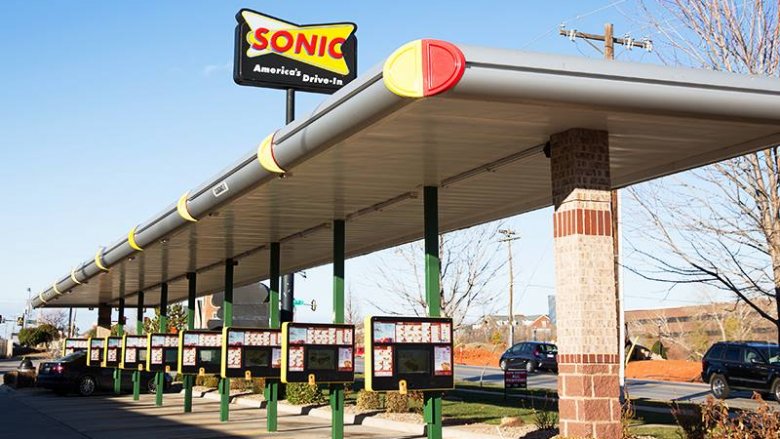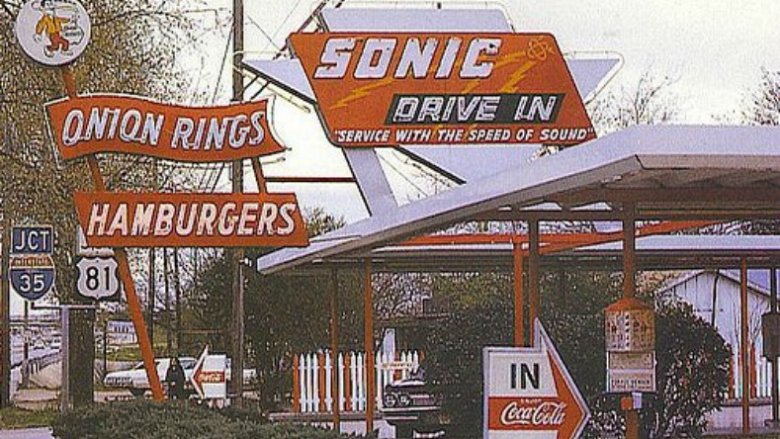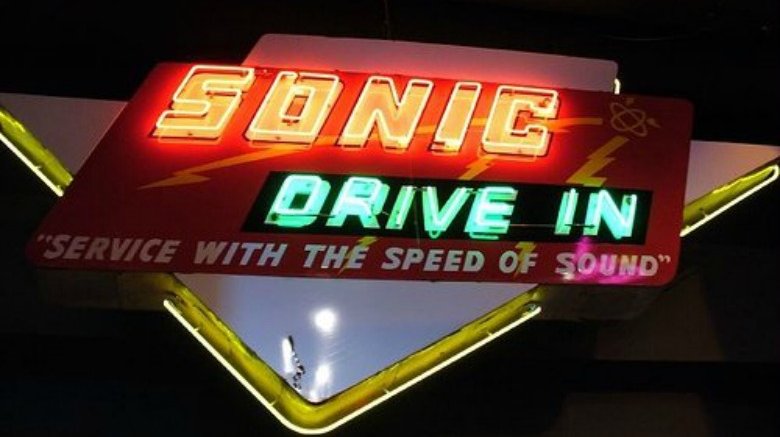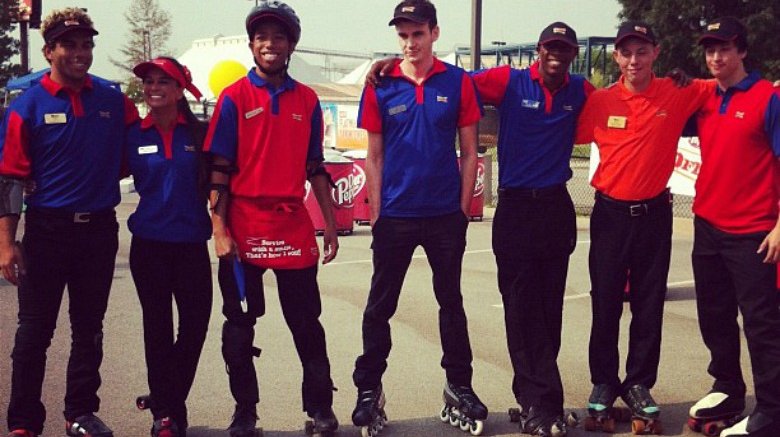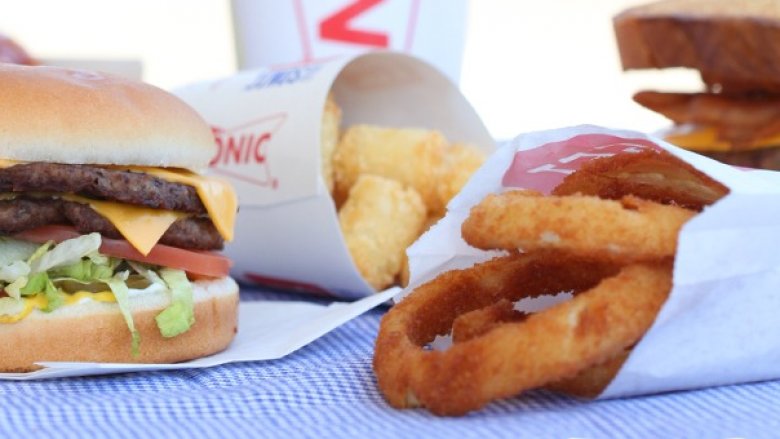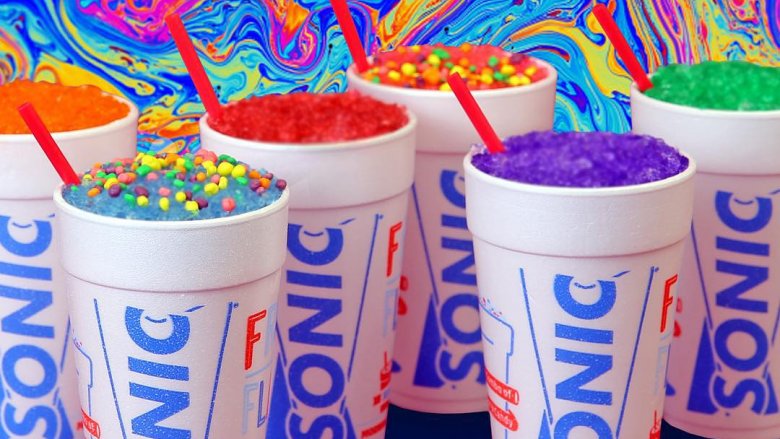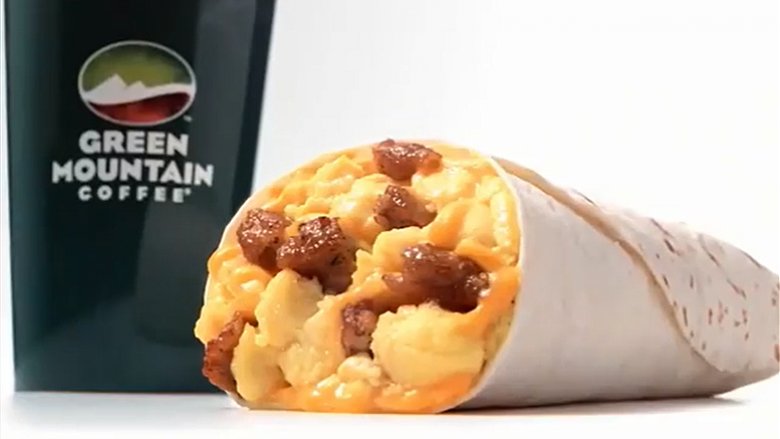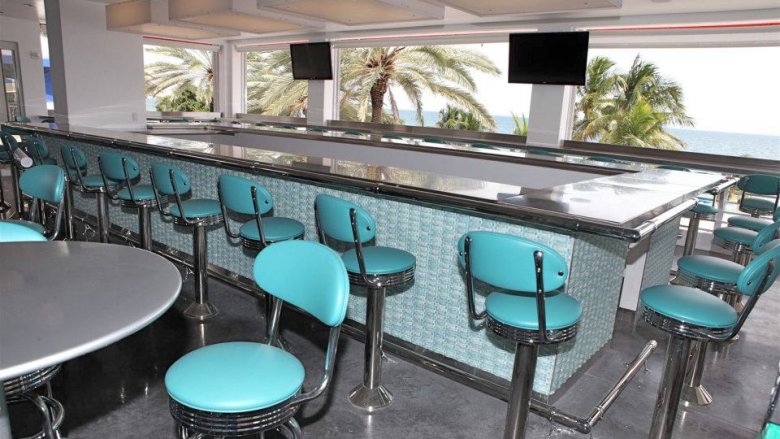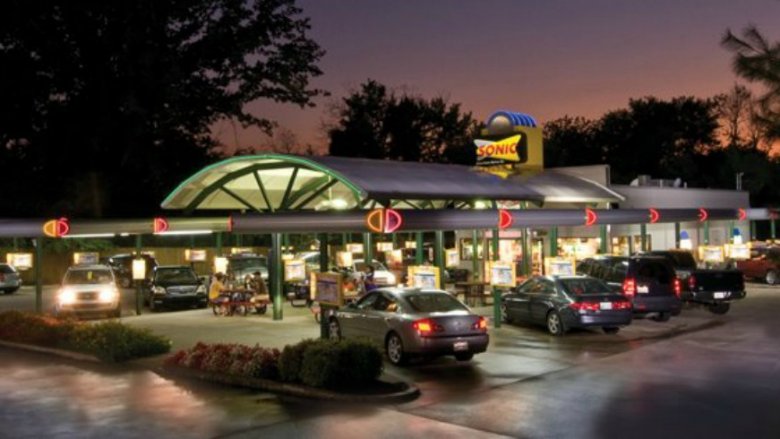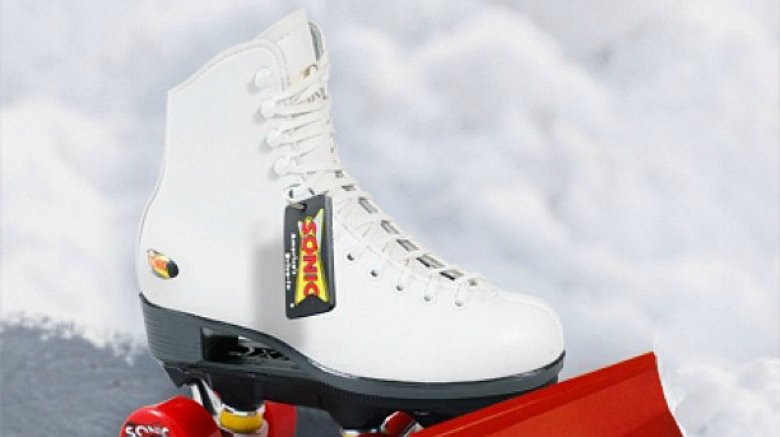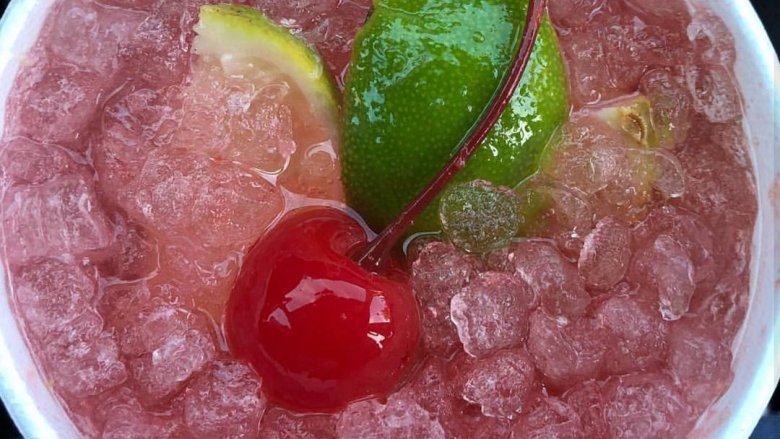The Untold Truth Of Sonic Drive-In
Sonic Drive-In may only be in 45 states, but because of its national advertising program, chances are you've heard of it (even if you don't actually have one nearby). This fast food chain is unlike other drive-thrus, as it still has a classic drive-in setup. When you get to the restaurant, you can park under an awning in the shade, order your food through a speaker, then have a carhop bring your food to you — on roller skates, no less. The environment gives you a taste of the past, though their fast food menu is rooted firmly in the future.
Even if you are lucky enough to live near a Sonic, there's still a lot about the chain you might not know. Read on to discover more about the true history of this fast food joint. It'll give you something to chew on the next time you're waiting for a carhop to deliver your food.
It started out as a root beer stand
Today Sonic Drive-In is known for its insane selection of beverages, but back in the day it kept things simple with one soft drink that's fallen a bit by the wayside: root beer.
The first Sonic was actually a root beer stand. Founder Troy Smith had just returned to Oklahoma from the WWII battle field and was looking for a new way to make a living. He purchased a root beer, hot dog, and hamburger stand at the outskirts of town, driving a bread delivery truck in the mornings and returning to the drive-in in the afternoon to work through the evening.
Root beer was the drink of the moment during the turn of the 20th century and remained hugely popular for the first half of it. The first A&W root beer stand was opened just after World War One, with similar stands (including the first Sonic) opening up through the 50s, when cola became more popular, and stands started focusing on their food as the main draw instead of their soda.
It used to have a different name
When Troy Smith first opened his root beer stand, it was called Top Hat. His next four franchises bore the same name, but soon his lawyers informed him that the name Top Hat was already copyrighted.
This left Smith's restaurants without a name. Luckily, he found inspiration in his own innovation. Unlike other drive-ins of the era, at which people would park their cars and then walk up to a window and order, Smith had added a speaker system at his stands. Customers could park their car beneath a canopy, order through the speaker, and have their food delivered by a carhop.
Their slogan? "Service With the Speed of Sound." When Smith heard the word "sonic," which means "speed of sound," he put two and two together, renaming the business Sonic Drive-In. The first Sonic Drive-In, a former Top Hat in Stillwater, Oklahoma, is still open for business today.
The carhops get a chance to prove their skills
Many of us can barely make it across a parking lot on foot without nearly getting hit by a car or tripping over a curb. That makes the carhops at Sonic even more impressive. They roller-skate from the kitchen right to your car, avoiding all sorts of obstacles along the way, all the while balancing a tray of burgers, snacks, and slushies.
It makes sense, then, that things can get competitive among the carhops. In fact, Sonic hosts a yearly skate-off for its employees at the company's headquarters in Oklahoma City. There, they compete in a 12-part obstacle course and have a chance to wow judges with a freestyle set, all for a grand prize of $1,500, a new pair of skates, and, of course, glory.
The obstacle course isn't your traditional stay inside the lines, swerve around the cones deal, either. Instead, competitors have to avoid things they'd face on the job, like skating under a rail, making their way through closed doors, and navigating sets of stairs all while holding a full tray of food and drinks. Pretty impressive, right?
The onion rings are fresh — and they have a strange ingredient
"Fast food" and "fresh" aren't exactly synonymous, but there are a few exceptions. Just as In-N-Out Burger cuts their potatoes fresh in store every day, so too does Sonic make their onion rings by hand.
The rings have a crunchy cornmeal coating, and most stores have a dedicated employee whose job it is to slice onions, batter them, and fry them. Sonic's rings have a distinctive sweet flavor, mingling with the salt to make you want to order a second batch before you're even done with your first.
According to one former employee, the secret to their sweetness is vanilla ice cream. Instead of a traditional egg mix, the onions are dipped into liquid vanilla soft serve mix, dipped in flour, dipped back in the soft serve mix, dipped into cornmeal, and then fried. It's a strange combination, but if you've ever tasted their onion rings, you have to admit that it works.
The amount of drink combinations is mind-blowing
Drinks are usually an afterthought when you hit up the drive through. You need something to wash down that spicy chicken sandwich and double bacon cheeseburger, right?
But at Sonic, the drinks are more than just an add-on; they're an art form. Rather than just offering the usual fountain drinks, they've created a massive menu of slushies, soft drinks, and milkshakes, all of which can be customized to make your perfect summer sip.
In fact, because of all of the custom options, Sonic technically serves more than 1.5 million different drinks. Add real fruit to your limeade, frozen lemonade, or slushy, try a slushy full of candy, or create an iced coffee concoction that doubles as dessert.
They've also got thousands of milkshake combos when you're craving something sweet, with everything from fresh bananas to Oreo cheesecake thrown in as an extra treat. It's reason enough to swing by.
They only use humane meat and eggs
"Humanely-sourced ingredients" isn't usually one of the first phrases that come to mind when we think about fast food, but Sonic has actually had an animal welfare policy in place since 2010, long before chains like McDonald's and Panera started making the change. They began to phase in cage-free eggs and sourcing pork from facilities that don't keep pigs in gestation crates. They also made it a goal to encourage their poultry suppliers to a more humane method of slaughtering chickens.
In 2016, they doubled down, setting specific goals for the full implementation of their animal welfare policy in all 3,500 Sonic restaurants in the US. They've committed to using 100 percent cage-free eggs by the years 2025, and to eliminating pork from suppliers that use gestation crates entirely by 2022.
When large chains like this make a change to their supply demands, it can actually have a big impact on the farming industry. Sonic buys about 155 million eggs a year, meaning their egg farmers will need to make significant changes in order to get them the product they need. With other chains doing the same, we could soon see the day when cage-free eggs are the new norm.
There was a beach-side Sonic that served beer
Sonic is known for its innovative menu and funny commercial spots, but it outdid its own fun factor in 2011 by opening a three-story beachside restaurant in Fort Lauderdale, Florida.
With views of the sandy beach and ocean, diners at Sonic Beach could enjoy traditional drive-through favorites along with a wider menu that included additions like beer and wine. An icy cold beer with a footlong chili cheese Coney at the end of a long day of swimming and sunbathing sounds like paradise on earth, right?
Sadly, all good things must come to an end, and Sonic's beachside oasis closed in 2015 after just four years in operation. There are other Sonic locations throughout southern Florida, but unfortunately, if you want alcohol with your meal, you'll have to brown bag it. Not that we recommend that... though if you bring your strawberry limeade slushy home and spike it with tequila, it makes for a pretty tasty margarita!
You need to be rich to open your own Sonic franchise
Have you ever dreamed of, say, owning a pizza restaurant so you could have as much cheesy pie as your heart desires, or a shoe store so you'd have first dibs on the hottest new kicks as they rolled in?
Well, we've had the same lofty dreams about owning a Sonic franchise, but after looking into it, it turns out you have to be a total baller in order to get in the fast food game.
For starters, you need to pay a $45,000 franchise fee before you even begin. This secures your location for 20 years. But that doesn't include any of the start-up costs, such as purchasing land, constructing your restaurant, hiring people, or sourcing ingredients. The low estimate for total start up costs is $865,000, while in pricier markets that number goes up to well over $3 million.
That's why Sonic requires that all franchise owners have a net worth of $1 million, with $500,000 in liquid assets per store, if they want to open 1-2 units. There goes our dream of all-you-can-drink slushies!
Carhops have to buy their own skates (and they're not cheap)
When a job requires you to wear something, you'd think that means they'd pay for it. Sadly, that's not the case for Sonic carhops, who have to buy their own skates.
They're allowed to buy any kind of skates they want, but since carhops are on their feet constantly, they get used heavily and are worth investing in. Sonic's recommended, branded skates cost $100, but the price rises when you factor in things like wheel and toe-stop replacements.
Once you have your skates, you're ready to go! While some locations have skater training (usually when a store is first opening), new hires are generally assumed to have some sort of skating skills on their own (or are at least expected to be able to stay on their feet), learning the ins and outs of carhop life through experience.
Another thing to know about your carhops? While in some locations they're paid a regular wage, in others they're considered tipped employees and paid below minimum wage. The next time you get your shake and burger delivered extra-fast, don't forget to give a tip.
People love them for their... ice?
For a fast food restaurant that's more known for its drinks than its food, the magic is all in the details. While the endless flavor combinations are a huge selling point, another thing that keeps customers coming back for more is their ice.
Instead of large cubes, Sonic uses crunchy-yet-soft nugget ice to cool its drinks. Because of its small size, it has more surface area, which cools your drink down faster. Nugget ice also supposedly absorbs flavors, so even when you're left with a cup of ice, it will taste lightly of whatever it was you were drinking.
The good news? You can buy a 10-pound bag of nugget ice at Sonic. At locations where this is available, they'll usually put a sign on the ordering screen, but if you don't see one just ask. You'll be able to take home your ice for between $2-$5, depending on location.
Once you have the delicious ice in your own home, you can use it for anything. It's particularly tasty in fruity cocktails, and even a simple glass of water tastes special when it's poured over a tall glass of nugget ice.
